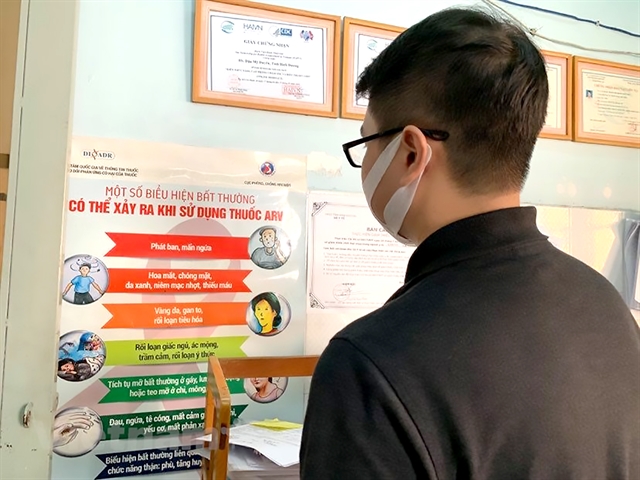 Op-Ed
Op-Ed

 |
| A man reads an infographic on abnormal signs that could occur during ARV treatment. Photo for illustration. — VNA/VNS Photo |
* Dr Maria Elena Filio Borromeo, UNAIDS Country Director to Việt Nam
HÀ NỘI — The 2023 UNAIDS Global AIDS Update Report that has just been released shows that there is a path that ends AIDS. Taking that path will also help ensure preparedness to address future pandemic challenges and advance progress across the Sustainable Development Goals.
The data and examples set out in this report make it very clear what that path is. It is not a mystery. It is a political and financial choice. HIV responses succeed when they are anchored in strong political leadership to: follow the evidence; tackle the inequalities holding back progress; enable community-led organisations in their vital role in the response; and ensure sufficient and sustainable funding.
Several countries are already on track. Botswana, Eswatini, Rwanda, the United Republic of Tanzania and Zimbabwe have already achieved the 95–95–95 treatment targets, and at least 16 others are close to doing so. Việt Nam is achieving substantial progress as well. It is estimated that the number of new HIV infections has decreased by 56 per cent between 2010 and 2022. Similarly, the estimated number of AIDS-related deaths has decreased by 32 per cent during the same period. For the 95–95–95 targets, Việt Nam is on track. As of the end of 2022, 89 per cent of people living with HIV are aware of their status. Of those who are aware of their status, 82 per cent are on treatment. And an impressive 99 per cent of people on treatment have achieved viral suppression. If decisive and timely actions continue and are further accelerated, it is likely that the country will achieve relevant objectives and targets stipulated in the National Strategy to End the AIDS Epidemic by 2030.
Massive efforts have been made to enhance access to combination HIV prevention services, which include harm reduction services, self-testing, lay testing, virtual interventions, and the increased provision of pre-exposure prophylaxis (PrEP). Việt Nam has witnessed a substantial rise in PrEP uptake, with a 59 per cent increase in PrEP usage in 2022 compared to 2021.
Progress has been strengthened by ensuring that legal and policy frameworks do not undermine human rights, but instead enable and protect them. In Việt Nam, HIV infection among people who inject drugs had decreased significantly. Yet, the country continues to be vigilant in ensuring that no resurgence occurs. Building on insights gained from the pilot of take-home methadone maintenance treatment (MMT) in 2021-2022, Việt Nam is expanding the pilot in 2023-2024, and work is underway to institutionalise take-home MMT in HIV legislation. This initiative is part of a national effort to enhance and diversify high-impact opioid substitution treatment (OST) services, with the goal of reaching more individuals in need of this life-saving intervention. The institutionalisation of take-home MMT aims to improve adherence and retention in the OST programme and further reduce new HIV infections among people who inject drugs.
These examples of putting people and communities first demonstrate how together we can end AIDS as a public health threat by 2030. As the report sets out, however, none of this will come automatically. As Việt Nam enters the last mile of the journey toward ending AIDS, we must be certain to ensure no vulnerable or marginalised group is left behind.
The pandemic’s ongoing cost to children is among the most painful reminders that AIDS is not over. The number of estimated new HIV infections among children in Việt Nam has been reduced by 60 per cent between 2010 and 2022, and the estimated AIDS-related deaths among children have remained low, with fewer than 200 estimated in 2022. However, the coverage of antiretroviral (ARV) treatment to prevent mother-to-child transmission of HIV has declined from 96 per cent in 2020 to 77 per cent in 2022, due to the impact of COVID-19 related issues. This decline in the programme coverage poses an increased risk of HIV infection among newborns and has the potential to undermine the positive outcomes achieved thus far by the national HIV response.
Punitive laws and policies, human rights violations and discrimination continue to greatly increase the risk of HIV transmission and sabotage efforts to control the epidemic among key populations. Recent data from Asia Pacific reveal that people in prisons and other closed settings have a six times higher risk of HIV acquisition than the general population. Timely and uninterrupted access to HIV services for all, including those in prisons and other closed settings, is crucial.
The obstacles in the way of progress are not fate. We can overcome them. The path that ends AIDS requires active collaboration – government, communities, UN, and development partners together. And it requires bold leadership. The route map set out in UNAIDS’ new global report shows how success is possible, in this decade – if we move together and with urgency. — VNS




